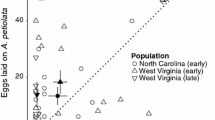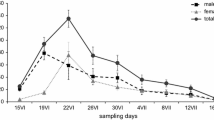Abstract
Numbers of the orange-tip butterfly were recorded on a permanent transect in Monks Wood National Nature Reserve between 1982 and 1993, together with numbers of its only larval food plant in the wood, Cardamine pratensis. Females of the butterfly lay their eggs on the newly opened flower heads of Cardamine and the larvae feed on the developing seed pods. They are extremely selective in their choice of plant for egg laying, choosing mainly large flower heads growing in open sunny locations. Larval survival is greatly reduced if the flower head is more than 8 days old at the time of egg laying, because the seed pods become too tough for feeding. Earlier studies showed that only one larva can survive on a flower head, because larvae are cannibalistic, but females tend to avoid plants carrying more than one egg, in response to an oviposition-deterring pheromone laid down at the time of egg laying. The numbers of flower heads of Cardamine fluctuate enormously between years, and the numbers of eggs follow these closely. There is a strong correlation between number of eggs laid and the availability of suitable flower heads, and this correlation was shown to be real and causal by the experimental provision of extra flower heads, which resulted in more eggs, laid over an extended period of oviposition. The main causes of mortality of the butterfly's young stages were egg infertility, cannibalism, predation, starvation, the grazing of flower heads by deer, and possibly the failure of the newly hatched larvae to feed adequately. Adult numbers were only weakly correlated with the numbers of young stages in the wood, and there appears to be a considerable amount of movement by the butterfly through the wood and surrounding farmland.
Similar content being viewed by others
Author information
Authors and Affiliations
Additional information
Received: 8 October 1996 / Accepted: 3 April 1997
Rights and permissions
About this article
Cite this article
Dempster, J. The role of larval food resources and adult movement in the population dynamics of the orange-tip butterfly (Anthocharis cardamines). Oecologia 111, 549–556 (1997). https://doi.org/10.1007/s004420050270
Issue Date:
DOI: https://doi.org/10.1007/s004420050270




